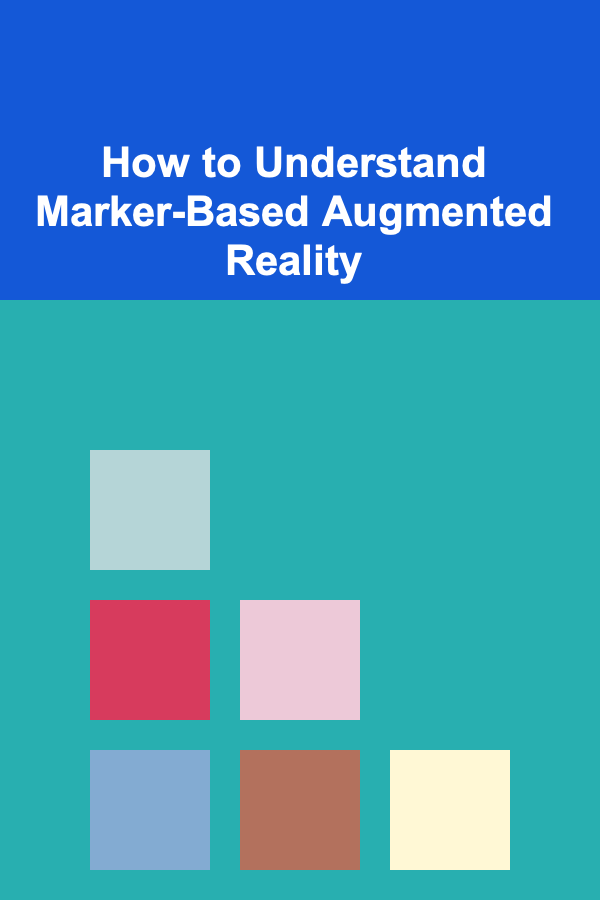
How to Understand Marker-Based Augmented Reality
ebook include PDF & Audio bundle (Micro Guide)
$12.99$8.99
Limited Time Offer! Order within the next:

Augmented Reality (AR) is a rapidly growing field that has revolutionized how we interact with digital content. Among the various types of AR technologies, Marker-Based AR holds a prominent place. This technology overlays digital content, such as 3D models, animations, or information, onto physical objects or images in the real world by using special markers. To truly understand Marker-Based AR, we need to explore its underlying principles, technologies, applications, and the challenges it presents. In this article, we will break down the key concepts and guide you through how Marker-Based AR works, its use cases, and its potential impact.
What is Marker-Based AR?
At its core, Marker-Based Augmented Reality relies on markers, typically images or physical objects, that are used to trigger digital content. These markers act as reference points for AR systems to identify and overlay virtual objects in the real world. The digital content is typically displayed in relation to the marker's position and orientation, creating an immersive AR experience.
Marker-Based AR works on the principle of computer vision. The AR system uses a camera or sensor to detect a marker's visual features, such as its color patterns, shape, or specific patterns. Once the marker is identified, the system uses the coordinates and orientation of the marker to place virtual objects in the real world, aligning them precisely with the marker's physical counterpart.
The Role of Markers
The markers used in Marker-Based AR can vary, but most commonly they are 2D images or QR codes . These markers are carefully designed with unique visual patterns that are easily detectable by AR systems. When the camera captures a marker, the system analyzes the visual features and then maps the virtual content to it. In some cases, the markers may be fiducial markers, which are specially designed patterns used in industrial applications, or even simple printed QR codes.
How Does Marker-Based AR Work?
Marker-Based AR typically follows a straightforward process:
- Detection of the Marker: The AR system first detects the marker using a camera or a sensor. The camera captures the image of the marker in real-time.
- Image Recognition : The system processes the image and identifies the marker based on its unique pattern or features. This is achieved through advanced computer vision algorithms that detect and recognize the marker.
- Positional Tracking: Once the marker is identified, the system determines the marker's position, orientation, and scale. This is crucial to ensure the virtual object aligns correctly with the real-world marker.
- Rendering the Augmented Content: After tracking the marker's position, the system renders digital content---such as 3D models, videos, or animations---onto the physical marker. The virtual content is placed and scaled relative to the marker's coordinates.
- Displaying the AR Experience: Finally, the digital content is displayed on the screen, creating the illusion that the virtual object is interacting with the real world, anchored to the marker.
This process happens in real-time, with the AR system continually tracking the marker's position and adjusting the virtual content accordingly as the user moves or changes the viewpoint.
Key Technologies Behind Marker-Based AR
Marker-Based AR relies on several technologies to deliver a smooth and immersive experience. Below, we explore the most critical technologies involved:
1. Computer Vision
Computer vision is the backbone of Marker-Based AR. It is responsible for recognizing and interpreting the visual information captured by the camera. AR systems use computer vision algorithms to:
- Detect markers in real time
- Recognize the unique features of the marker
- Track the position and orientation of the marker
These algorithms process the images and analyze visual features like color, shape, or specific patterns. Advanced methods like feature detection (using algorithms like SIFT or SURF) help the AR system to precisely identify the marker, even under varying conditions, such as changing lighting or angles.
2. SLAM (Simultaneous Localization and Mapping)
Although SLAM is most commonly associated with Markerless AR, it can play a crucial role in improving the accuracy of Marker-Based AR, particularly in environments where multiple markers are involved. SLAM allows the AR system to map the real-world environment while simultaneously tracking the position of the marker. This helps to create a more immersive AR experience, particularly when the user is moving around.
3. 3D Rendering
Once the marker has been detected and its position tracked, 3D rendering comes into play. 3D rendering software or engines, such as Unity3D or Unreal Engine, are used to create and render the virtual content over the real-world markers. The virtual objects are then scaled and oriented according to the real-world markers, creating a realistic AR experience.
4. Camera Calibration
For accurate positioning and alignment of digital content, the AR system relies on proper camera calibration. Camera calibration ensures that the AR system can accurately measure distances, angles, and scale. This is crucial for maintaining the illusion that virtual objects are properly anchored to the physical markers.
5. Software Development Kits (SDKs)
Many AR platforms use SDKs (Software Development Kits) to facilitate the development of Marker-Based AR experiences. SDKs provide developers with pre-built tools and libraries to handle marker detection, tracking, and rendering. Some popular AR SDKs include ARKit (for iOS), ARCore (for Android), and Vuforia, which support both marker-based and markerless AR development.
Applications of Marker-Based AR
Marker-Based AR has found applications across various industries, thanks to its ability to create immersive and interactive experiences. Here are some notable use cases:
1. Retail and Marketing
In retail, Marker-Based AR is used to enhance the shopping experience. For example, stores use AR to allow customers to visualize products in 3D before purchasing. A customer could scan a product's image with their smartphone or tablet, and the AR system would display a 3D model of the product, allowing the customer to examine it from different angles.
This technology is also used in advertising, where physical posters, billboards, or magazine ads act as markers. Scanning these markers can trigger AR content, such as videos, product demonstrations, or special offers, creating a more engaging advertisement.
2. Education and Training
In education, Marker-Based AR is used to bring educational content to life. By scanning images or textbooks, students can access interactive 3D models, animations, or videos that complement their learning. For example, biology students could scan a textbook illustration of the human heart and view a 3D model of the heart that they can rotate and explore in detail.
In training simulations, Marker-Based AR helps trainees interact with digital information superimposed on physical equipment or environments. This is particularly useful in fields like medicine, engineering, and aviation, where hands-on experience is vital.
3. Gaming and Entertainment
Marker-Based AR is also widely used in gaming and entertainment. Games often require physical interaction with markers to unlock new levels, items, or challenges. By scanning a marker on a physical object, players can summon 3D characters or activate in-game actions that enhance the gaming experience.
4. Museum and Art Exhibits
Museums and art galleries use Marker-Based AR to offer additional layers of information about artifacts or artwork. Visitors can scan specific objects or artworks, triggering AR content such as detailed descriptions, animations, or even virtual reconstructions of historical scenes, providing a richer, more immersive museum experience.
5. Healthcare
In healthcare, Marker-Based AR can be used for anatomy learning, surgical planning, and rehabilitation. For instance, surgeons can use AR to overlay 3D scans or models of organs directly onto the patient during surgery, offering real-time visualization that aids in decision-making.
Challenges in Marker-Based AR
Despite its numerous applications, Marker-Based AR faces a few challenges that developers and users need to be aware of:
1. Marker Detection and Recognition
Marker-Based AR systems rely heavily on the quality of the markers themselves. If the marker is too small, distorted, or unclear, it can become difficult for the AR system to detect and recognize it. Variations in lighting, angle, or environmental conditions can also impact the accuracy of marker detection.
2. Limited Interaction
While Marker-Based AR is engaging, the level of interaction is often limited compared to other AR systems, such as Markerless AR or Spatial AR. The user must interact with the environment through predefined markers, which can limit the fluidity and flexibility of the experience.
3. Physical Marker Dependency
Since Marker-Based AR depends on physical markers, it may not be as scalable in environments where markers are not easily distributed or visible. This can create challenges when trying to implement AR in large-scale outdoor environments or public spaces.
4. Resolution and Field of View
The resolution of the camera and the field of view can also impact the quality of Marker-Based AR experiences. A low-resolution camera or a small field of view may result in less accurate tracking, leading to a poor AR experience.
The Future of Marker-Based AR
Marker-Based AR is only scratching the surface of its potential. As camera technology, computer vision, and AR SDKs continue to improve, we can expect the accuracy, ease of use, and accessibility of Marker-Based AR to increase dramatically. In the near future, we might see more seamless integration of AR into everyday life, making it easier for businesses, educators, and consumers to leverage this technology.
Conclusion
Understanding Marker-Based AR requires knowledge of its underlying technologies, the process through which it works, and its numerous applications across various industries. While it faces challenges, the power of Marker-Based AR lies in its ability to overlay digital content onto the physical world, providing users with immersive, interactive experiences. As the technology continues to evolve, we can expect even greater advancements in how we interact with and experience the world around us through augmented reality.

How To Build a Strong Social Media Moderation Strategy
Read More
How to Connect with Neighbors After Moving In
Read More
How to Create a Checklist for Time Capsule Contents
Read More
How To Master Robot Navigation and Mapping (SLAM)
Read More
How To Master Financial Forecasting for Small Businesses
Read More
How to Build a Stronger Core for Life
Read MoreOther Products

How To Build a Strong Social Media Moderation Strategy
Read More
How to Connect with Neighbors After Moving In
Read More
How to Create a Checklist for Time Capsule Contents
Read More
How To Master Robot Navigation and Mapping (SLAM)
Read More
How To Master Financial Forecasting for Small Businesses
Read More